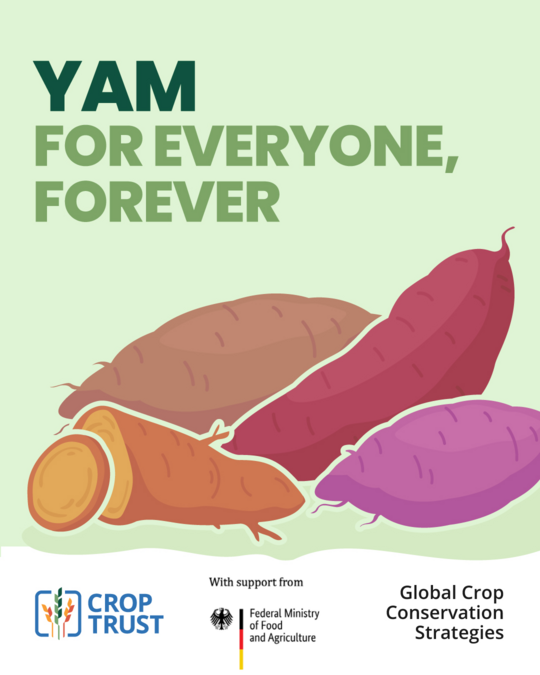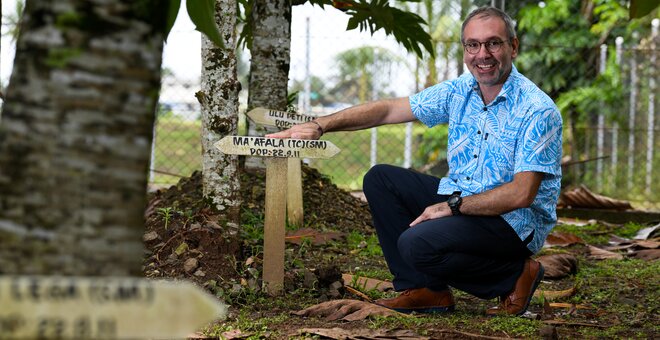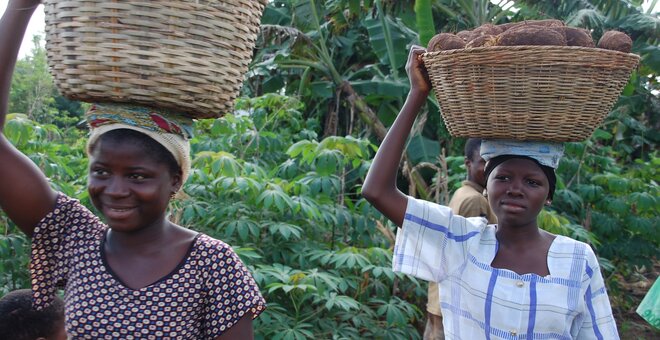The Crop Trust, along with its strategic partners, is developing conservation strategies to protect the genetic diversity of the world’s food crops. This initiative is funded by the German Federal Ministry of Food and Agriculture (BMEL).
Yields of yams could be boosted—and with them food security—by using their biodiversity more efficiently, according to a strategy for yam conservation facilitated by the Crop Trust.
White, yellow, pink or purple. Sweet, bitter or tasteless,
Yams are a staple food for millions of people and an important component in traditional medicine.
Resilient and robust, yams can be grown on small plots with high yields and stored for months after harvest without losing nutritional value.
Farmers need to grow the best varieties of yams possible to ensure their food security.
But growing the ideal yam requires a diversity of genetic material.
Some yams are conserved in genebanks around the world but those are isolated and have limited resources.
A global crop conservation strategy, developed by the Crop Trust and our partners will help to make that yam diversity available for everyone, forever.
Did you know?
- Yams (Dioscorea spp.) are a staple food for millions of people in tropical countries.
- Yams provide pharmacologically active compounds in traditional medicine and for the pharmaceutical industry.
- Yams are cultivated in about 50 tropical countries.
- The world annual production is approximately 72 million tonnes of fresh tubers.
- More than 98% of yams are cultivated in Africa, with only four countries (Nigeria, Côte d’Ivoire, Ghana and Benin) accounting for 93% of this output. Latin America and the Caribbean rank a distant second among the three producing regions.
- There are 11 main food yam species (D. alata, D. bulbifera, D. cayenensis, D. dumetorum, D. esculenta, D. japonica, D. nummularia, D. oppositifolia, D. pentaphylla, D. rotundata and D. trifida).
- Yams are harvested every season and replanted using tuber pieces to regenerate the plant.
- Yam tubers can be stored for 4–6 months in ambient tropical conditions without significant deterioration of their nutritional properties.
- In many regions, yams play a very important part in the cultural life of the people, especially in the “yam belt” of West Africa but also in parts of Asia, the Caribbean and the Pacific.
- Yam diversity is stored in about 30 genebanks around the world.
- The world’s largest collection is held by IITA, in Nigeria; the only other international collection is at the Centre for Pacific Crops and Trees in Fiji, run by the Pacific Community (SPC).
Related stories about yams
CePaCT Donor Roundtable: Discussing support for the Pacific’s most important genebank
Donors, Pacific Community (SPC) scientists and the Crop Trust will meet in Suva, Fiji, at the end of March to discuss ways to raise money for the genebank of SPC’s Centre for Pacific Crops and Trees (CePaCT).
CePaCT conserves a...
14 Mar 2019
14 Mar 2019
Yam: Feast and Forest
Yet again, citizens of the region of Mahi yesterday celebrated the Feast of Yams. It was held at the Royal Palace of Savalon in the presence of a huge crowd and a group of dignitaries.
On the special day, King Tossoh Gbaguidi...
2 Dec 2014
2 Dec 2014



